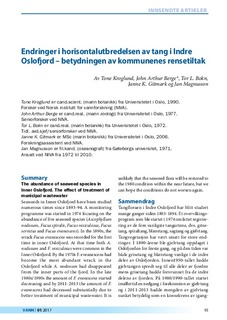| dc.contributor.author | Kroglund, Tone | |
| dc.contributor.author | Berge, John Arthur | |
| dc.contributor.author | Bokn, Tor L. | |
| dc.contributor.author | Gitmark, Janne K | |
| dc.contributor.author | Magnusson, Jan | |
| dc.date.accessioned | 2018-10-23T09:05:43Z | |
| dc.date.available | 2018-10-23T09:05:43Z | |
| dc.date.issued | 2017 | |
| dc.identifier.citation | Vann. 2017, 52 (1), 87-103. http://www.vannforeningen.no | nb_NO |
| dc.identifier.issn | 0042-2592 | |
| dc.identifier.uri | http://hdl.handle.net/11250/2569072 | |
| dc.description.abstract | Tangfloraen i Indre Oslofjord har blitt studert mange ganger siden 1893-1894. Et overvåkingsprogram som ble startet i 1974 omfattet registrering av de fem vanligste tangartene, dvs. grisetang, spiraltang, blæretang, sagtang og gjelvtang. Tangvegetasjon har vært utsatt for store endringer. I 1890-årene ble gjelvtang oppdaget i Oslofjorden for første gang, og på den tiden var både grisetang og blæretang vanlige i de indre deler av Oslofjorden. Innen1950-tallet hadde gjelvtangen spredt seg til alle deler av fjorden mens grisetang hadde forsvunnet fra de indre delene av fjorden. På 1980/1990-tallet startet imidlertid en nedgang i forekomsten av gjelvtang og i 2011-2013 hadde mengden av gjelvtang sunket betydelig som en konsekvens av igangsatte rensetiltak for kommunale avløp. Det er likevel lite trolig at tangfloraen i fjorden innen overskuelig fremtid vil kunne restitueres til tilstanden en hadde på slutten av 1800-tallet. Sannsynligvis er det beste en kan håpe på at tilstanden på ny ikke forverres i forhold til situasjonen i 2011-2013. | nb_NO |
| dc.description.abstract | The abundance of seaweed species in Inner Oslofjord. The effect of treatment of municipal wastewater Seaweeds in Inner Oslofjord have been studied numerous times since 1893-94. A monitoring programme was started in 1974 focusing on the abundance of five seaweed species (Ascophyllum nodosum, Fucus spiralis, Fucus vesiculosus, Fucus serratus and Fucus evanescens). In the 1890s, the wrack Fucus evanescens was recorded for the first time in inner Oslofjord. At that time both A. nodosum and F. vesiculosus were common in the Inner Oslofjord. By the 1970s F. eveanescens had become the most abundant wrack in the Oslofjord while A. nodosum had disappeared from the inner parts of the fjord. In the late 1980s/1990s the amount of F. evanescens started decreasing and by 2011-2013 the amount of F. evanescens had decreased substantially due to better treatment of municipal wastewater. It is unlikely that the seaweed flora will be restored to the 1980 condition within the near future, but we can hope the conditions do not worsen again. | nb_NO |
| dc.language.iso | nob | nb_NO |
| dc.publisher | Norsk vannforening | nb_NO |
| dc.title | Endringer i horisontalutbredelsen av tang i Indre Oslofjord – betydningen av kommunenes rensetiltak | nb_NO |
| dc.type | Journal article | nb_NO |
| dc.type | Peer reviewed | nb_NO |
| dc.description.version | publishedVersion | nb_NO |
| dc.source.pagenumber | 87-103 | nb_NO |
| dc.source.volume | 52 | nb_NO |
| dc.source.journal | Vann | nb_NO |
| dc.source.issue | 1 | nb_NO |
| dc.identifier.cristin | 1573011 | |
